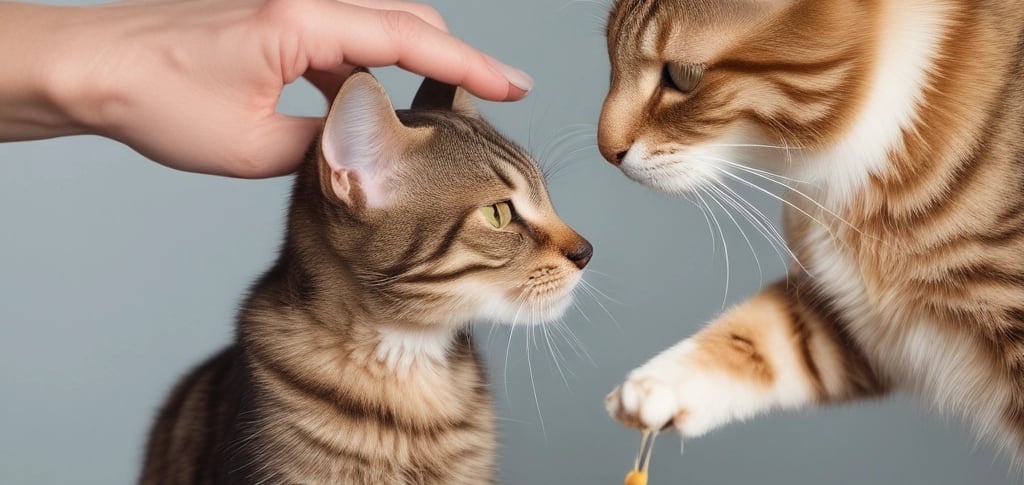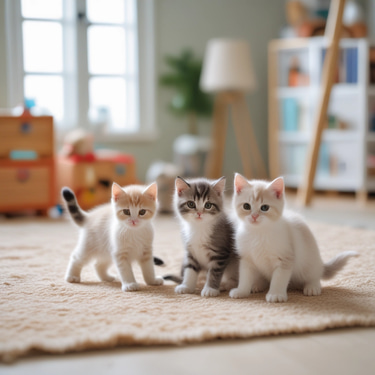Navigating Feline Finesse: A Guide for First-Time Cat Owners on Handling Finicky Cats
7/20/20255 min read


Understanding Your Cat's Finicky Behavior
Every cat possesses a unique set of behaviors that can often puzzle first-time owners. Understanding these behaviors is essential for fostering a healthy and harmonious relationship with your feline companion. A significant factor influencing a cat's finicky nature is its breed characteristics. Different breeds exhibit distinct temperaments and preferences; for example, Siamese cats are known for their vocal tendencies, while Persians may prefer a more laid-back environment. Recognizing these inherent traits can help owners better cater to their feline friends, ultimately reducing instances of finicky behaviors.
Additionally, early socialization plays a crucial role in shaping a cat's behavior. Cats that have been exposed to various environments, people, and experiences during their formative months tend to develop more adaptable temperaments. Conversely, cats with limited socialization may exhibit anxiety or become particular about their food and environment. Understanding a cat's past experiences can provide insights into why they may react differently to certain stimuli, particularly when it involves food or new situations.
Natural instincts also contribute to the finicky behavior observed in many cats. As obligate carnivores, their wild ancestors thrived on a diet rich in protein. Therefore, a cat’s food preferences may be rooted in instinct, influencing their rejection of certain textures or flavors. It is imperative for first-time cat owners to be patient and observant, noting their pet's unique likes and dislikes. By carefully monitoring your cat's eating habits and behaviors, you can gain a clearer understanding of what truly resonates with their individual needs.
Ultimately, recognizing these factors allows owners to adapt their approach, creating a nurturing environment that respects their cat's unique personality and preferences. With time, patience, and observation, owners can foster a fulfilling relationship with their finicky feline.
Creating an Inviting Environment
Establishing a welcoming living space is essential for the well-being of your finicky cat. A comfortable environment not only promotes security but also encourages your feline companion to explore and adjust to their new surroundings. Begin by selecting an appropriate feeding area. This space should be quiet and away from high-traffic zones to foster a sense of safety during mealtime. Consider investing in a non-slip feeding mat to minimize mess and provide a defined area for your cat's food and water bowls.
Clean, fresh water is crucial for maintaining your cat's health, and it’s advisable to change the water daily. Cats can be particular about their water sources, so utilizing a cat water fountain could entice your finicky friend to drink more. The flowing water mimics a natural environment, ensuring hydration, which is vital, especially for those on dry food diets.
Creating a stress-free atmosphere is another key step in making your home inviting. Cats are often sensitive to loud noises and sudden movements. To minimize disruptions, choose a relatively quiet room for them to relax in and try to maintain a routine that offers predictability. Additionally, consider incorporating soft surfaces such as blankets and cat beds that will encourage your cat to rest comfortably.
Introducing a variety of food options gradually is essential for finicky eaters. Start with small portions of different flavors to allow your cat to adapt without feeling overwhelmed. Monitor their reactions closely; this can help you understand their preferences. Gradually incorporating new foods can heighten their interest and may help discover a flavor that appeals to them. A calm and inviting environment, combined with careful food exploration, will provide your feline with a sense of well-being, helping them thrive in their new home.
Experimenting with Food Preferences
Understanding a finicky cat's eating habits can be a challenging yet rewarding process for new cat owners. One of the essential strategies in addressing a picky eater is to experiment with various types of cat food to determine their preferences. Cats may be receptive to different options, such as wet, dry, or semi-moist food, each offering unique flavors and textures that can appeal to their taste buds. Wet food, for instance, often has a stronger aroma and a palatable texture that many cats find appealing, while dry food is known for its convenience and long shelf life.
To successfully transition your finicky feline to new food, it is important to do so gradually. Begin by mixing a small amount of the new food with their current diet. A ratio of about 25% new food to 75% familiar food is a good starting point. Over several days, slowly adjust this ratio by increasing the proportion of the new food while observing your cat’s reaction. This approach minimizes the risk of upsetting your cat's sensitive stomach, enabling them to adapt to the new flavor gradually.
Another effective technique involves "topping" their existing food with enticing additions. For example, consider sprinkling a small amount of freeze-dried meat, or adding a splash of low-sodium chicken broth to enhance the aroma. Such toppings can spark your cat's interest and encourage them to explore the flavors of their current food alongside these new elements. Additionally, rotating between the flavors and brands periodically can further pique their curiosity and may prevent boredom with their meals.
Ultimately, patience and experimentation play crucial roles in discovering your cat's food preferences. By systematically altering their diet with different food types and techniques, you can help ensure a balanced and enjoyable eating experience for your finicky feline.
Building Trust and Encouraging Positive Associations
Establishing trust between an owner and a finicky cat is crucial for creating a harmonious living environment. When cats feel secure in their surroundings, they are more likely to engage positively with their owners, particularly during feeding times. One effective strategy for cultivating this trust is through the implementation of positive reinforcement techniques. By offering treats or engaging in affectionate interactions when a cat exhibits desired behaviors, owners can foster a sense of security and encourage habits that align with healthy eating practices.
For instance, associating feeding times with delicious treats can lead to more enthusiastic eating behaviors among finicky felines. This method not only enhances the cat's experience but also reinforces the idea that mealtime is a positive occasion. It is important to ensure that the treats are appropriate for the cat's dietary needs and are offered in moderation. Owners should also consider utilizing their cat's favorite toys or activities during feeding times to create an enjoyable routine.
Developing a consistent feeding schedule can further assist cats in predicting meal times, thus reducing anxiety related to food availability. When a cat knows when to expect their meals, they are less likely to exhibit challenging behaviors associated with hunger or nutritional dissatisfaction. A routine can be established by feeding the cat at the same times each day and using specific cues, such as sounds or verbal commands, to signal mealtime.
In addressing particularly challenging behaviors, gentle training methods should be employed. Owners must demonstrate patience and understanding, recognizing that trust-building takes time. Gradually desensitizing a cat to particular situations and positively reinforcing calm behavior can help mitigate issues related to food aversion or reluctance to engage with feeding routines. Over time, these practices contribute toward a strong, trusting bond between the owner and their finicky feline companion.
Affiliate Disclosure:
Some of the links on this website are affiliate links, which means I may earn a small commission if you make a purchase through them — at no extra cost to you. As an experienced cat lover, I only recommend products I truly believe in and think would be helpful to fellow cat lovers. Thank you for supporting this blog!
Sharing our love and knowledge about cats.
Felines
© 2025. All rights reserved.
